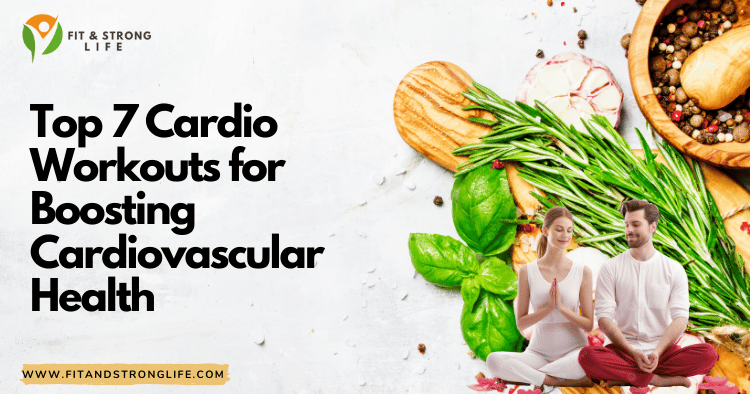Table of Contents:
- Introduction
- 1. Running
- 2. Cycling
- 3. Swimming
- 4. Rowing
- 5. HIIT (High-Intensity Interval Training)
- 6. Dancing
- 7. Jump Rope
- Conclusion
- FAQs
Introduction
Cardiovascular health is crucial for overall well-being, encompassing the health of your heart, blood vessels, and circulatory system. Engaging in regular cardiovascular exercise can help lower blood pressure, improve cholesterol levels, and reduce the risk of heart disease. In this article, we will explore the top seven cardio workouts that can help you boost your cardiovascular health. Whether you’re a beginner or a seasoned athlete, there’s something here for everyone!
“Investing in your heart health today can pay dividends for years to come.”
1. Running
Running is one of the most accessible and effective forms of cardiovascular exercise. Not only does it burn calories, but it also strengthens your heart and lungs.
Benefits:
- Improves heart efficiency: Regular running increases your heart’s stroke volume, meaning it pumps more blood with each beat.
- Burns calories: Running can burn anywhere from 300 to 800 calories per hour, depending on your weight and intensity.
Tips for Getting Started:
- Start with a walk/run program to build endurance.
- Invest in a good pair of running shoes to avoid injuries.
“A good pair of shoes can make all the difference in your running journey.”
For more information, check out the Top 10 Essential Supplements for Optimal Fitness in 2024.
2. Cycling
Cycling, whether on a stationary bike or outdoors, is another fantastic way to enhance your cardiovascular fitness. It’s low-impact, making it suitable for people of all ages.
Benefits:
- Strengthens leg muscles: It builds the quadriceps, hamstrings, and calves, promoting overall strength and stability.
- Joint-friendly: Unlike running, cycling is gentle on the joints, reducing the risk of injury.
Tips for Getting Started:
- Start with short rides and gradually increase your distance.
- Ensure your bike is properly fitted to avoid discomfort.
“Cycling not only tones your legs but also gives you a sense of freedom on the road!”
For additional insights, refer to the Top 5 Carbs for Enhanced Fitness Performance in 2024.
3. Swimming
Swimming is a full-body workout that not only boosts cardiovascular health but also enhances flexibility and muscle strength.
Benefits:
- Works multiple muscle groups: Swimming engages the entire body, making it effective for overall fitness.
- Great for recovery: The buoyancy of water lessens the impact on your joints.
Tips for Getting Started:
- Start with basic strokes like freestyle and backstroke.
- Practice breath control and technique to maximize efficiency.
“The water is your friend; let it support you as you swim toward better health.”
You can also explore 10 Essential Plant-Based Foods for Peak Fitness Performance to complement your swimming routine.
4. Rowing
Rowing is an excellent full-body workout that effectively increases cardiovascular fitness while also building strength.
Benefits:
- Engages large muscle groups: Works the legs, back, and arms, leading to improved overall strength.
- Low-impact: The seated position and smooth motion make it easy on the joints.
Tips for Getting Started:
- Focus on proper form to prevent injuries.
- Start with short sessions and increase gradually.
“Rowing is not just a workout; it’s a rhythm of strength and endurance.”
To further enhance your fitness journey, consider the Top 10 Foods for Boosting Endurance Performance.
5. HIIT (High-Intensity Interval Training)
HIIT involves short bursts of intense activity followed by rest or low-intensity periods. It’s a time-efficient way to boost cardiovascular fitness.
Benefits:
- Burns more calories in less time: HIIT can burn up to 30% more calories than traditional workouts.
- Improves metabolism: After a HIIT workout, your body continues to burn calories at an elevated rate.
Tips for Getting Started:
- Choose exercises you enjoy, such as burpees, sprints, or cycling.
- Start with a work-to-rest ratio of 20:40 and adjust as you progress.
“HIIT: where every second counts in the race for fitness.”
For more on effective recovery, check out Top 7 Recovery Techniques to Boost Strength Training Results.
6. Dancing
Dancing is not only fun but also a great way to improve cardiovascular health while expressing yourself.
Benefits:
- Boosts mood: The combination of music and movement releases endorphins, improving mental health.
- Improves coordination: Regular dancing helps with balance and agility.
Tips for Getting Started:
- Join a dance class or follow online tutorials.
- Experiment with different styles, from Zumba to ballroom dancing.
“Dance like nobody’s watching, and your heart will thank you!”
Also, consider Top 7 Diet Plans to Boost Your Fitness Journey in 2024 to complement your active lifestyle.
7. Jump Rope
Jumping rope is a simple yet effective workout that can significantly improve cardiovascular health.
Benefits:
- Improves coordination: Jumping rope helps develop timing and rhythm.
- Portable and inexpensive: All you need is a jump rope and a space to work out.
Tips for Getting Started:
- Start with short intervals and focus on your form.
- Gradually increase your speed and duration.
“A jump rope is a gateway to a healthier heart and a happier you!”
For a deeper dive into nutrition, check out 10 Essential Nutrition Tips for Effective Strength Training.
Conclusion
Incorporating cardiovascular workouts into your routine is essential for maintaining heart health and overall fitness. Whether you choose running, swimming, or dancing, the key is to find activities that you enjoy and can commit to regularly. Remember to start slow, listen to your body, and progressively challenge yourself. With consistency and dedication, you’ll be on your way to a healthier heart!
“Your heart is a muscle; the more you use it, the stronger it becomes.”
FAQs
Q: How often should I do cardio workouts?
A: It’s recommended to engage in at least 150 minutes of moderate aerobic activity or 75 minutes of vigorous activity each week.
Q: Can I combine different cardio workouts?
A: Absolutely! Mixing different types of cardio can keep your routine exciting and target different muscle groups.
Q: What if I have health concerns?
A: Always consult with a healthcare professional before starting any new exercise program, especially if you have pre-existing health conditions.
Q: How can I track my cardiovascular progress?
A: Consider using fitness trackers or apps that monitor your heart rate, distance, and overall performance to keep track of your progress.
For more information on cardiovascular health, visit the Centers for Disease Control and Prevention (CDC).
Feel free to share your thoughts on these cardio workouts or any experiences you’ve had with them in the comments below! Happy exercising!




